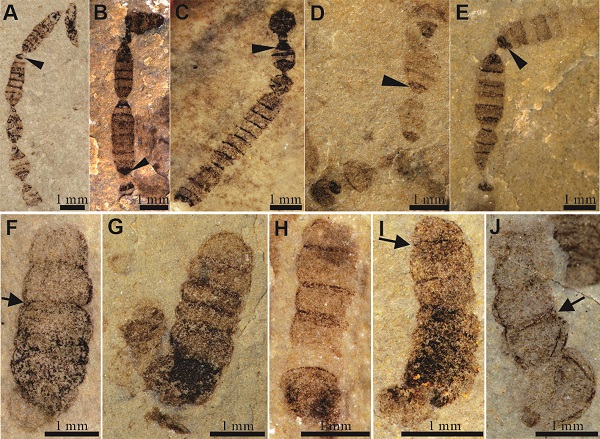Macroalgae, which are usually multicellular or coenocytic eukaryotes, play an important role, both ecologically and biogeochemically, in modern marine ecosystems. Molecular clock studies suggest that eukaryotic algae have an evolutionary deep history tracing back to the Paleoproterozoic to Mesoproterozoic. However, fossil biomarkers indicate that prokaryotes were the only notable primary producers in pre-Cryogenian oceans and it was not until the Cryogenian that eukaryotic algae rose to ecological prominence. The fossil record of macroalgae during the Tonian Period is poorly documented, hampering our ability to evaluate the potential ecological and geobiological importance of early macroalgae. Moreover, compared with Ediacaran macroalga assemblages, the taxonomic diversities of Tonian macroalga assemblages are usually considered much lower and their morphology relatively simple.
A team of scientists led by Dr. PANG Ke from Nanjing Institute of Geology and Palaeontology, Chinese Academy of Sciences (NIGPAS), and Drs. LI Guangjin and CHEN Lei from Shandong University of Science and Technology collected thousands of specimens from a fossiliferous horizon in the ca.~910 Ma to ~720 Myr rocks (Shiwangzhuang Formation, Tumen Group) from western Shandong Province, North China. Related results have recently been published in the Precambrian Research.
The Shiwangzhuang assemblage consists of macroscopic and diversified carbonaceous compression fossils. In total, the Shiwangzhuang assemblage consists of twelve genera, sixteen species and one type of unnamed filaments, including a new genus and six new species: Anqiutrichoides constrictus n. gen. and sp.; Eosolena magna n. sp.; Protoarenicola baishicunensis n. sp.; Protoarenicola shijiacunensis n. sp.; Pararenicola gejiazhuangensis n. sp.; Sinosabellidites huangshanensis n. sp. The taxonomic diversity of the Shiwangzhuang assemblageis remarkable. It is more diverse than many other Tonian macrofossil assemblages all over the world. Indeed, the Shiwangzhuang assemblage nearly matches the Ediacaran Lantian and Miaohe biotas in terms of taxonomic diversity.
Eleven taxa of the Shiwangzhuang assemblage are likely eukaryotic organisms on the basis of morphological features and sub-millimetric to millimetric size, whereas four taxa of the Shiwangzhuang assemblage are likely of cyanobacterial origin and two taxa are left undetermined in terms of biological affinity. Three taxa, including Anqiutrichoides constrictus, Eosolena magna, and Chuaria colony, show evidence of simple multicellularity with delicately preserved cellular structure. Among them, Anqiutrichoides constrictus and Eosolena magna consist of submillimetric to millimetric giant cells and comparable to giant-celled green algae. Seven tubulartaxa, including Protoarenicola baiguashanensis, Protoarenicola baishicunensis, Protoarenicola shijiacunensis, Pararenicola huaiyuanensis, Pararenicola gejiazhuangensis, Sinosabellidites huainanensis, and Sinosabellidites huangshanensis, are likely coenocyticalgae with diagnostic transverse annulations. Among them, Protoarenicolais characterized byannulated tubes with a bulbous terminal structure at one end, Pararenicola is characterized by annulated tubes with a constricted opening at one end and a round and closed termination at the other end, and Sinosabellidites is characterized by annulated tubes with two round and closed ends.
The new Shiwangzhuang assemblage provides an important window onto the evolution of pre-Cryogenian macroalgae. It indicates that some eukaryotic clades had achieved macroscopic growth through simple multicellularity or coenocytism, paving the way, either ecologically or phylogenetically, for the eventual appearance of complex multicellularity. The abundant occurrence of diverse macroalgae in the Shiwangzhuang Formation also implies that the Tonian diversity of multicellular or coenocytic macroalgae is probably underestimated and macroscopic photoautotrophs may have played important roles, both ecologically and geobiologically, at least at a local scale in the Tonian.
In addition, there are some biostratigraphically significant genera, including the Chuaria-Tawuia and Sinosabellidites-Protoarenicola-Pararenicola assemblages, indicating a Tonian age for the Shiwangzhuang Formation.
This research was supported by the National Key Research and Development Program of China, National Natural Science Foundation of China, Chinese Academy of Sciences, Shandong University of Science and Technology Research Fund, Taishan Scholars Project, and State Key Laboratory of Palaeobiology and Stratigraphy.
Reference: Li, G#., Chen, L.#*, Pang, K.*, Zhou, G., Han, C., Yang, L., Lv, W., Wu, C., Wang, W., Yang, F. An assemblage of macroscopic and diversified carbonaceous compression fossils from the Tonian Shiwangzhuang Formation in western Shandong, North China. Precambrian Research,2020, 346: 105801.

Fig.1 Chuariacircularis and Chuaria colonies (A-C), Tawuia dalensis (E-G), Vendotaenia sp. (H-I), Mucoplagum primitivum (J), Glomulus filamentum (K), Unnamed filaments (L) and Beltina danai (M) from the Shiwangzhuang assemblage
Fig.2. Protoarenicola baiguashanensis (A-B), Protoarenicola baishicunensis n. sp. (C-E), Protoarenicola shijiacunensis n. sp. (F-G), Pararenicola huaiyuanensis (H-I), Pararenicola gejiazhuangensis n. sp. (J–K), Sinosabellidites huainanensis (L), Sinosabellidites huangshanensis n. sp. (M) from the Shiwangzhuang assemblage

Fig.3 Anqiutrichoides constrictus n. gen. and sp. (A-E) and Eosolena magna n. sp. (F-J) from the Shiwangzhuang assemblage
